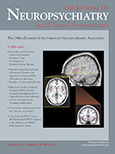Bulimia Nervosa Treated With an Adapted Version of Carroll’s Cognitive-Behavioral Approach for Treatment of Cocaine Addiction
To the Editor: Bulimia nervosa (BN) is difficult to treat. Although cognitive-behavioral (CB) therapy for BN seems to be effective, some patients do not benefit from it. A case of BN, treated with the Carroll’s CB approach for cocaine addiction, is described. At the first visit, the patient satisfied the BN diagnosis and was taking sertraline. She had completed standard CB therapy with poor results. After 12 sessions of Carroll’s approach, the patient did not satisfy the BN diagnosis anymore and had stopped taking sertraline. Carroll’s CB approach seems promising for treatment-resistant BN cases.
Case Report
Bulimia nervosa is a disorder difficult to treat. Cognitive behavioral therapy for BN (CBT-BN) is considered the leading treatment, although it has achieved only 37% cumulative binge eating abstinence.1
A growing body of evidence suggests that BN can also be conceptualized as an addictive disorder. Thus, few psychological interventions used to treat addiction have been suggested for BN with inconsistent results.2
I report the case of “Ms. C,” a 38-year-old woman with a family history of anxiety and BN. She started binge eating and following a restricting diet at the age of 14 years. When she was 34 years old, she sought help from a specialized center in eating disorders and received standard CBT and sertraline (150 mg/day) with poor results.
At 38 years of age, Ms. C was binge eating on average once per day and using laxatives on average twice per week to compensate the weight gain; thus, she asked for a psychiatric visit. During the first visit, a diagnosis of BN purging type was formulated via the Structured Clinical Interview for DSM IV–Clinical Version. The severity of symptoms was assessed by the Eating Disorder Inventory3 (total score = 90). Body mass index was 20.79.
After the assessment, the patient was informed about the diagnosis and encouraged to begin a normal eating routine; the need to follow CBT different from the one received was introduced; and a program to discontinue sertraline was outlined. An adapted version of Carroll’s cognitive-behavioral approach for treatment of cocaine4 addiction was proposed.
In the following 12 sessions, Carroll’s behavioral approach was administered to deal with cravings and negotiating tough decisions; supporting motivation, and commitment to stop binge eating and using compensatory behaviors; recognizing and avoiding risky situations; and recognizing seemingly irrelevant decisions. After 12 sessions, Ms. C was having binge eating episodes less than once per week, had a body mass index of 20.14, an Eating Disorder Inventory total score of 67, and was no longer on sertraline treatment. Three further sessions, focused on cognitive restructuring, were completed to consolidate the well-being achieved. Thereafter, Ms. C no longer met the diagnostic criteria for BN (Eating Disorder Inventory total score = 66; body mass index = 20.14) and maintained improvement at 2 years of follow-up.
Discussion
The treatment of BN represents a challenge for clinicians. Although CBT-BN is the most effective therapy, about two thirds of patients do not benefit from it.
Because there is a growing debate on considering BN as an addictive disorder, the interventions known as effective in addiction should be taken into account as therapy for BN. In particular, the cognitive behavioral approach proposed by Carroll4 for cocaine addiction could be adapted to treat BN subjects. According to the present case report, it might give promising results. Based on the staging of treatment resistance of psychiatric disorders,5 the best candidates for Carroll’s CBT could be BN purging type patients who already had a standard CBT-BN with poor results and did not benefit from other psychological or pharmacological interventions.
1 : Psychological treatments for bulimia nervosa and binging. Cochrane Database Syst Rev 2009; 4:CD000562Medline, Google Scholar
2 : Ten years of treating eating disorders: what have we learned? A personal perspective on the application of 12-step and wellness programs. Adv Mind Body Med 2008; 23:18–26Medline, Google Scholar
3 : Development and validation of a multidimensional eating disorder inventory for anorexia nervosa and bulimia. Int J Eat Disord 1983; 2:15–34Crossref, Google Scholar
4 : A Cognitive-Behavioral Approach: Treatment of Cocaine Dependence. Rockville, MD, National Institute of Health, 1998Google Scholar
5 : The clinical process in psychiatry: a clinimetric approach. J Clin Psychiatry 2012; 73:177–184Crossref, Medline, Google Scholar



